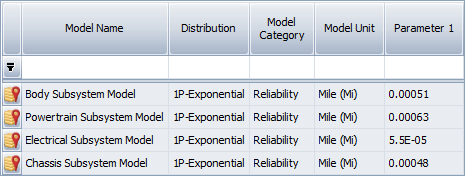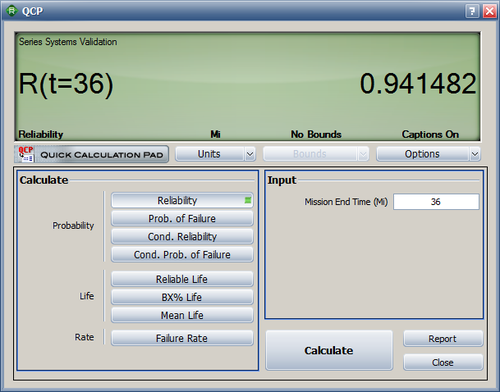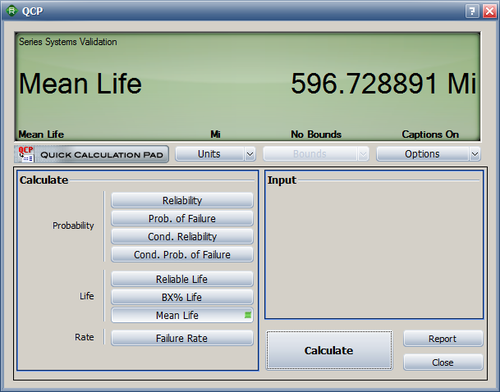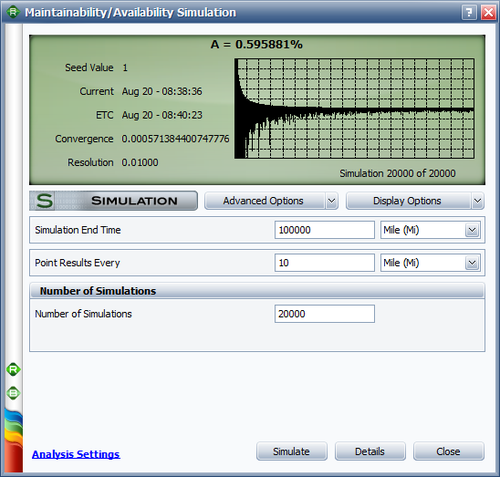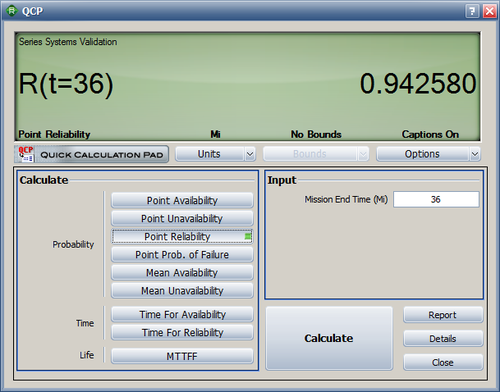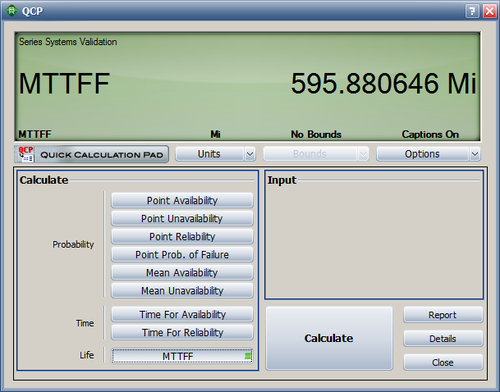Series Systems RBD: Difference between revisions
Jump to navigation
Jump to search
Kate Racaza (talk | contribs) No edit summary |
Kate Racaza (talk | contribs) No edit summary |
||
| Line 1: | Line 1: | ||
{{Reference Example|{{Banner BlockSim Reference Examples}}}} | {{Reference Example|{{Banner BlockSim Reference Examples}}}} | ||
This example validates the results for series systems in BlockSim's analytical and simulation diagrams. | This example validates the results for series systems in BlockSim's analytical and simulation diagrams. | ||
{{Reference_Example_Heading1}} | {{Reference_Example_Heading1}} | ||
The data set is from example 4.2 on page 69 in the book ''Life Cycle Reliability Engineering'' by Dr. Guangbin Yang, John Wiley & Sons, 2007. | The data set is from example 4.2 on page 69 in the book ''Life Cycle Reliability Engineering'' by Dr. Guangbin Yang, John Wiley & Sons, 2007. | ||
{{Reference_Example_Heading2}} | {{Reference_Example_Heading2}} | ||
| Line 29: | Line 31: | ||
Then, the reliability at 36,000 miles is calculated as R(36,000) = exp(-16.75 × 10<sup>-4</sup> × 36) = 0.9415. The mean mileage to failure (MTTF) is obtained as MTTF = 1 / λ = 1 / 16.75 × 10-4 = 597,000 miles. | Then, the reliability at 36,000 miles is calculated as R(36,000) = exp(-16.75 × 10<sup>-4</sup> × 36) = 0.9415. The mean mileage to failure (MTTF) is obtained as MTTF = 1 / λ = 1 / 16.75 × 10<sup>-4</sup> = 597,000 miles. | ||
{{Reference_Example_Heading4|BlockSim}} | {{Reference_Example_Heading4|BlockSim}} | ||
In BlockSim, the vehicle RBD is configured as shown below: | In BlockSim, the vehicle RBD is configured as shown below: | ||
[[Image:series_rbd.png|center]] | [[Image:series_rbd.png|center]] | ||
Each component is modeled using a 1-parameter exponential distribution with the given lambda values: | |||
Each component is modeled using a 1-parameter exponential distribution with the given lambda values. (If the exponential models show the mean times, choose '''Application Setup > Calculations ''' and then clear the '''Use mean time for the exponential distribution''' check box.): | |||
[[Image:series_models.png|center]] | [[Image:series_models.png|center]] | ||
''Analytical Proof''' | '''Analytical Proof''' | ||
In the QCP, the reliability at 36,000 miles is estimated to be 94. | In the QCP, the reliability at 36,000 miles is estimated to be 94.1482% | ||
[[Image:series_qcprel.png|center|500px]] | [[Image:series_qcprel.png|center|500px]] | ||
And the mean life (MTTF), which is the mileage to failure, is obtained as 596 | And the mean life (MTTF), which is the mileage to failure, is obtained as 596.728891 miles. | ||
[[Image:series_qcpmttf.png|center|500px]] | [[Image:series_qcpmttf.png|center|500px]] | ||
| Line 62: | Line 65: | ||
The point reliability at 36,000 miles is calculated in the QCP as 94. | The point reliability at 36,000 miles is calculated in the QCP as 94.2580%. | ||
[[Image:series_simqcprel.png|center|500px]] | [[Image:series_simqcprel.png|center|500px]] | ||
And the mean time to first failure (MTTFF), which is the mean mileage to first failure, is obtained as 595 | And the mean time to first failure (MTTFF), which is the mean mileage to first failure, is obtained as 595.880646 miles. | ||
[[Image:series_simqcpmttf.png|center|500px]] | [[Image:series_simqcpmttf.png|center|500px]] | ||
| Line 73: | Line 76: | ||
Both results are within 0.2% error. More accurate results may be obtained via simulation if the number of simulations is increased. | Both results are within 0.2% error. More accurate results may be obtained via simulation if the number of simulations is increased. | ||
Latest revision as of 15:51, 20 August 2015
New format available! This reference is now available in a new format that offers faster page load, improved display for calculations and images and more targeted search.
As of January 2024, this Reliawiki page will not continue to be updated. Please update all links and bookmarks to the latest references at BlockSim examples and BlockSim reference examples.


